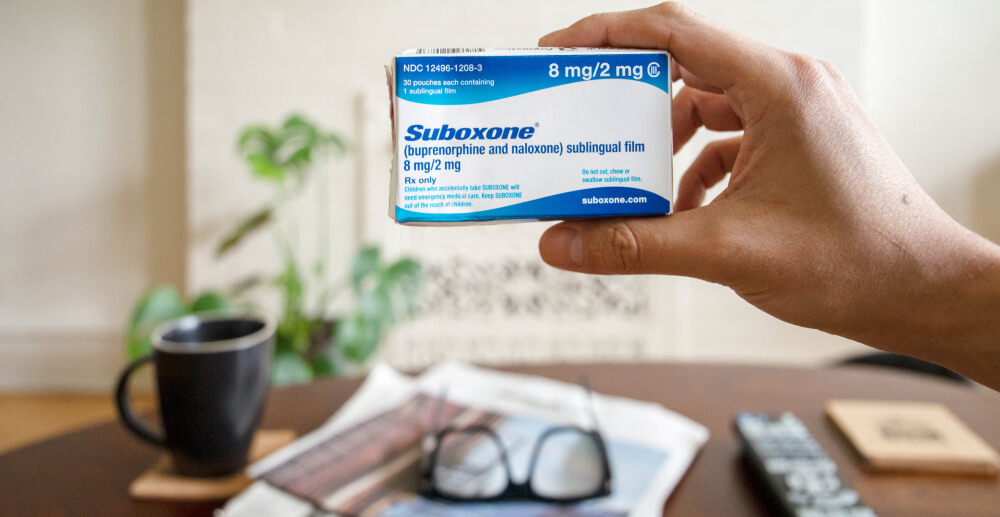Opioids can cause stomachaches, nausea, and constipation … and Suboxone isn’t immune from these side effects. These suggestions may help.
Suboxone, a combination medication containing buprenorphine and naloxone, is a widely used treatment for opioid use disorder (OUD). While Suboxone is effective in helping people with OUD manage their addiction and lead healthier lives, it may come with gastrointestinal side effects for some individuals.
In this blog post, we’ll explore the gastrointestinal side effects of Suboxone and discuss strategies to mitigate them, ensuring a more comfortable treatment experience for individuals undergoing OUD treatment.
What is Suboxone?
Suboxone is a prescription medication approved by the Food and Drug Administration (FDA) to treat opioid dependence and addiction by reducing withdrawal symptoms and cravings. It contains two active ingredients:
- Buprenorphine: A partial opioid agonist, buprenorphine works by binding to the mu opioid receptors in the brain occupying them and partially activating them. It helps reduce cravings and withdrawal symptoms without producing the euphoric effects common to full agonist opioids.
- Naloxone: An opioid antagonist that blocks the effects of other opioids and helps prevent misuse of Suboxone.
Suboxone is available as a sublingual film; Zubsolv, another similar buprenorphine/naloxone medication, comes in the form of a sublingual tablet. Generic options are available in both forms.
Stomach issues: Some common gastrointestinal side effects of Suboxone
While Suboxone is generally well-tolerated, some individuals may experience gastrointestinal side effects during treatment. Gastrointestinal means that it affects the digestive system. Opioids are well known for causing this kind of issue, to the point that medical professionals have a name for it: opioid-induced bowel dysfunction. This can affect people who are using opioid pain medication as directed, people who are misusing opioids, and people who are using medication-assisted treatment like Suboxone. These side effects can include:
- Nausea and vomiting: Nausea (feeling “sick to your stomach”) and vomiting are among the most commonly reported gastrointestinal side effects of Suboxone.
- Constipation: Opioid medications, including Suboxone, are known to slow down bowel movements, leading to constipation. Symptoms of constipation include:
- Straining during a bowel movement
- Having lumpy stools
- Having less than three bowel movements in a week
Chronic constipation can be uncomfortable and may require medical attention.
- Diarrhea: In some cases, Suboxone treatment may cause diarrhea, disrupting your daily schedule. prolonged diarrhea may lead to dehydration if not managed.
- Abdominal Pain: Abdominal pain, stomachache, stomach cramps, or discomfort may occur as a result of gastrointestinal upset associated with Suboxone use. This symptom can range from mild to severe.
What can help with the gastrointestinal side effects of Suboxone?
While gastrointestinal side effects of Suboxone can be worrisome, there are several ways individuals can manage them effectively:
Hydration
Maintaining adequate hydration is essential, especially for individuals experiencing diarrhea or vomiting. Drinking plenty of water can help prevent dehydration and alleviate symptoms. Aim for at least eight glasses of water daily to keep your digestive system hydrated and functioning smoothly. You can also include an electrolyte drink like Gatorade or Powerade, or something like Pedialyte.
Dietary Modifications
Adjusting what you eat can also help manage gastrointestinal side effects. This may involve:
- Eating a fiber-rich diet: Incorporating fiber-rich foods such as fruits, vegetables, whole grains, and legumes into your diet can help alleviate constipation associated with Suboxone use. Fiber helps soften stool, adds bulk to them, and promotes regular bowel movements.
- Avoiding certain trigger foods: Avoiding spicy, greasy, or heavy foods may help reduce stomach discomfort and nausea. Also, identify and avoid foods or beverages that may cause or worsen diarrhea, such as spicy foods, caffeine, or dairy products.
- Eating small, frequent meals: Instead of large meals, opt for smaller, more frequent meals throughout the day. This can help prevent nausea and make digestion easier on the stomach.
- Taking Suboxone after food: Consuming a small meal or snack 20 minutes before taking Suboxone can help reduce your risk of nausea and vomiting. Note: Because Suboxone is taken sublingually, you should not eat or drink anything for 15 minutes before taking it and 15 minutes after it has fully dissolved.
Antiemetic medications
Antiemetics are medications that reduce nausea and vomiting. Some individuals experiencing severe nausea or vomiting find that over-the-counter (OTC) antiemetics like Pepto-Bismol or Dramamine help a lot. Others receive prescription antiemetic medications from their provider. Some people even turn to folk remedies like candied ginger or peppermint tea (staying outside of that window of 15 minutes before and after taking Suboxone). If you find that you’re throwing up when you take Suboxone, talk to your provider so they can help you choose the best remedy.
Stool softeners
Most OTC stool softeners are safe to use during your treatment, and if necessary, your healthcare provider may prescribe stool softeners. They help your intestines absorb more water and relieve constipation caused by Suboxone.
Probiotics
Incorporating probiotic supplements or foods rich in probiotics, such as yogurt, kefir, or sauerkraut, into your diet may help restore the balance of beneficial bacteria in the gut. This can support overall digestive health and mitigate gastrointestinal side effects.
Medication adjustments
If gastrointestinal side effects persist or become severe, your provider may recommend adjusting the dosage or timing of Suboxone.
Some individuals may find relief from gastrointestinal side effects by splitting their daily dose of Suboxone into smaller, more frequent doses. This can help minimize the impact of the medication on the digestive system.
Be sure to consult with your healthcare provider before making any changes to your medication regimen.
Physical Activity
Engaging in regular, mild physical activity, such as walking or gentle exercise, can help stimulate bowel movements and relieve constipation.
Conclusion
Gastrointestinal side effects are a common concern for individuals undergoing Suboxone treatment for opioid use disorder. However, by understanding these side effects and following appropriate measures, you can reduce the impact of these symptoms.
Individuals need to communicate openly with their healthcare providers about any side effects they experience with Suboxone, as timely intervention ensures better outcomes and successful recovery from opioid dependence.








